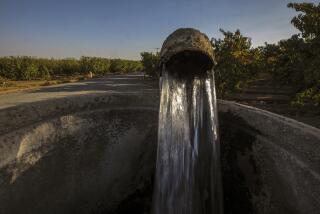Editorial: Garcetti’s ambitious goal for L.A.’s water supply
Spurred by the drought, but planning for long-term sustainability, Mayor Eric Garcetti has set an ambitious and important goal for Los Angeles: to reduce the amount of water it purchases by 50% in 10 years. That’s a decade sooner than water managers had anticipated, and it’s a big change for a city that currently buys nearly 80% of its supply. This executive directive — if it’s achieved — would remake Los Angeles’ water management, requiring major strides in conservation, water recycling and groundwater cleanup.
This is doable. The Department of Water and Power has long had plans on the books that could significantly increase the city’s local water supply. But over the years, for whatever reason — lack of funding or political will or some combination of the two — the projects have been delayed. They include expanding catch basins and other systems to capture stormwater and replenish aquifers, developing the infrastructure to safely treat and reuse wastewater, encouraging more residents and businesses to install drought-tolerant landscaping and finally building a treatment plant to clean up contaminated San Fernando Valley groundwater.
Of course, this is also an expensive and politically fraught mandate. That’s why so many important local water projects have stalled. Just look at Los Angeles’ effort to recycle and reuse wastewater, which was shelved more than a decade ago after opponents derided it as “toilet to tap.” Now it is back in the planning stage after Orange County and other regions embraced it. Garcetti, along with the City Council, will have to build support for controversial projects and be willing to ask ratepayers — who are already paying more for expensive imported water — to fund much-needed investments in the local water supply.
The mayor’s directive is significant for another reason. For the first time in its modern history, Los Angeles is planning a significant reduction in imported water. More than a century ago, city leaders realized that the growing population could not be served by the Los Angeles River and regional aquifers, and so they began to rely on imported water, first by building an aqueduct from the Owens River in the Eastern Sierra and later by buying water delivered from Northern California and the Colorado River. While previous city leaders have talked about reducing the city’s dependence on imported water, Garcetti has set a target and a deadline to do it. The question is whether he and the city’s political leadership will stay focused and committed to making these ambitious water goals a reality.
Follow the Opinion section on Twitter @latimesopinion
More to Read
A cure for the common opinion
Get thought-provoking perspectives with our weekly newsletter.
You may occasionally receive promotional content from the Los Angeles Times.










